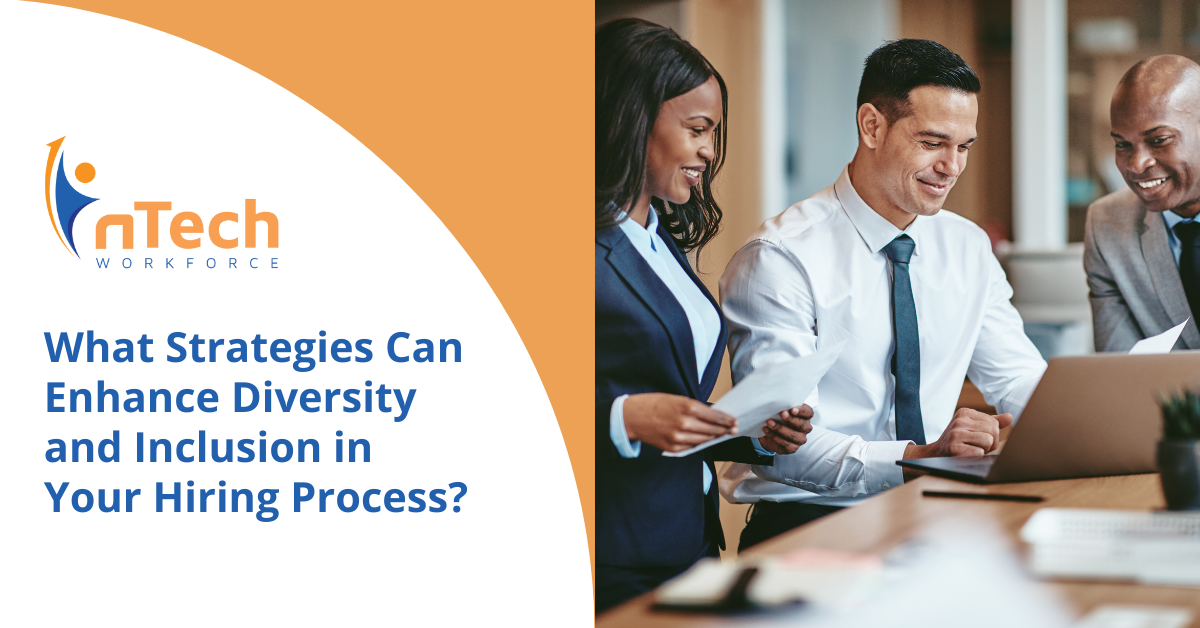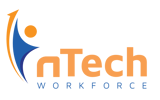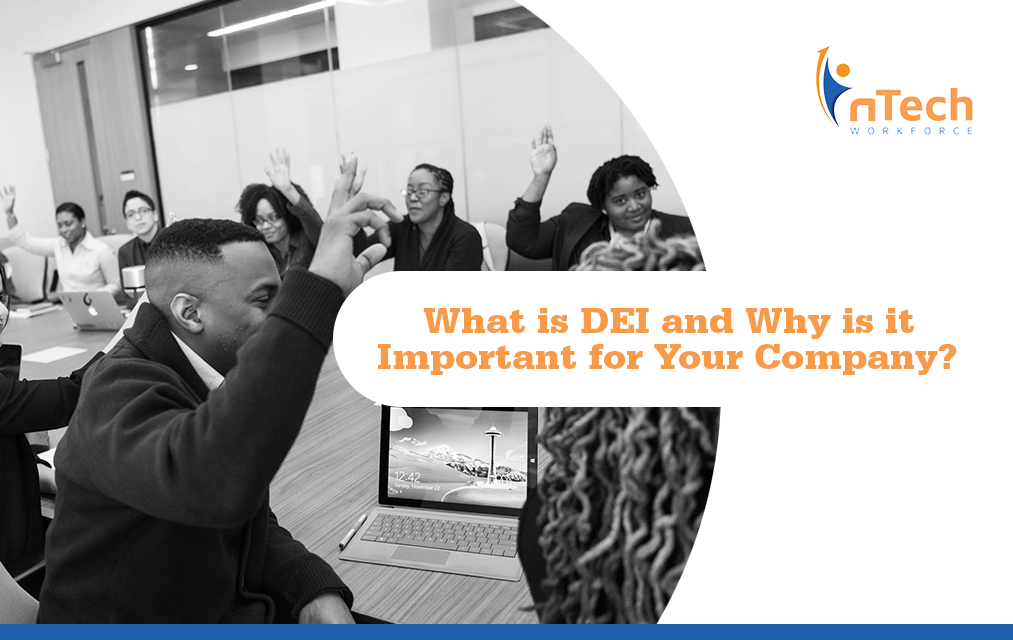3 min read
What Strategies Enhance Diversity and Inclusion in Your Hiring Process?
![]() nTech Workforce
:
Jan 16, 2024 8:00:00 AM
nTech Workforce
:
Jan 16, 2024 8:00:00 AM

In today's global market, diversity and inclusion have become more than just HR buzzwords. They are essential components of a successful hiring process and a thriving workplace culture. Arthur Ransier, Director of Business Strategy at nTech Workforce, shares his insights on incorporating diversity and inclusion into the hiring process. This article explores practical strategies to enhance diversity and inclusion, offering guidance for hiring managers, CHROs, Diversity and Inclusion Officers, and anyone committed to improving their recruitment practices.
Before diving into strategies, it’s important to define Diversity, Equity, and Inclusion (DEI). According to a previous edition of nSider: “Diversity, Equity, and Inclusion (DEI) is the key to a successful and productive workplace. DEI programs focus on involving people of different genders, sexualities, races, age groups, religions, cultures, abilities and disabilities, sexual orientations, backgrounds, expertise, skills, and experiences. The goal of DEI is not just representation and participation of such diverse groups; rather, it focuses on having their voice heard in a business setting, offering fair treatment, and providing all team members with a sense of belonging to a shared vision.”
How Can Organizations Incorporate Diversity Into Their Hiring Processes?
Ransier emphasizes that it's less about incorporating diversity and inclusion and more about being aware of barriers and biases. He states, "I look at diversity as a strategic objective and view inclusion and equity as two key elements of a winning strategy." This approach requires a proactive stance in identifying and dismantling barriers that may limit qualified candidates from advancing through the hiring process.
According to an article from Washington State University Carson College of Business, embodying and modeling DEI principles is key: “To begin this process, leaders may need to invest time in their understanding of how systems of privilege and oppression function in society and how these dynamics can impact an organization’s way of operating. This may involve educating themselves on topics such as unconscious bias, systemic discrimination, and cultural competence.”
What Are Strategies For Attracting a Diverse Pool of Candidates?
According to Ransier, attracting a diverse pool of candidates involves several key strategies:
- Needs Assessment and Job Analysis: Identify biases in job needs and analyze job tasks to ensure they are not based on unintentional biases or stereotypes.
- Total Rewards/Compensation Package: Ensure equitable compensation and consider benefits that might attract a broader candidate pool.
- Job Description: Use inclusive language and be clear about expectations, avoiding stereotypes or assumptions.
- Sourcing Candidates: Diversify recruitment channels and partner with community-based organizations to reach a broader range of candidates.
- Screening and Interviewing: Employ objective evaluation methods and train hiring managers on recognizing and countering cognitive biases.
In What Ways Can Unconscious Bias Be Mitigated?
What is unconscious bias? According to the Employers Network for Equality and Inclusion: “Unconscious biases are simply our unintended people preferences; they are formed by our socialization, our personal experiences, and the representations of different groups in the media.” A 2019 Deloitte study found that: “Whether based on gender, age, race, ethnicity, sexuality, disability or military status, more than 60 percent of respondents reported a presence of bias in their workplace.”
Mitigating unconscious bias is crucial for a fair hiring process. Ransier advises, "Remember to evaluate candidates objectively, treat applicants fairly, and be mindful of cognitive bias." Using structured interviews, and competency models, and involving diverse individuals in the hiring process can reduce the influence of bias. An article from Harvard Business School suggests: “Ensure you are writing inclusive job descriptions so a diverse range of candidates enters your application pool. Be aware of how video background and noise out of a candidate’s control influence your perception and offer alternatives. Standardize your interview process so that each candidate answers the same questions and performs the same work tests to ensure a fair performance review including multiple perspectives.”
How Can Organizations Measure Their Diversity and Inclusion Initiatives?
Success measurement starts with the existing workforce. Ransier suggests, "Begin with existing employees and transform company culture to create an environment where those from diverse backgrounds can thrive." Organizations should disaggregate hiring, occupational, and turnover data to gain actionable insights. This approach helps identify systemic barriers and fosters a culture conducive to diversity.
An article from Qualtrics also suggests investing in a system that can track and maintain data: “As you start to attract more diverse candidates, ensure you know where they’re coming from so you can identify your best campaigns and channels. You’ll also want to see how they’re progressive through the hiring process. This might mean an applicant tracking system (ATS) that provides metrics for every source, program, or campaign.”
What Role Do Employee Resource Groups Play In Promoting Diverse Teams?
Indeed defines Employee Resource Groups (ERGs) as: “Voluntary, employee-led groups that promote a sense of belonging and support inclusivity within the workplace.”
ERGs and affinity networks are pivotal in fostering diversity. Ransier explains, "They increase the collective voice, influence, resources, and action toward building a culture and systems that are inclusive and equitable." These groups create environments where underrepresented individuals can thrive and contribute significantly to the organization's diversity initiatives.
The Path Forward: Transforming Hiring Practices for Inclusivity
Enhancing diversity and inclusion in the hiring process is a multifaceted endeavor that requires a strategic and proactive approach. By acknowledging and addressing biases, refining hiring practices, and fostering a workplace culture that values diversity, organizations can build teams that reflect the richness and variety of the global talent pool.
Learn more about cultivating diversity, equity, and inclusion (DEI) during the candidate sourcing and hiring process by clicking here to discover how nTech Workforce is leading the way.

What Are Best Practices in Hiring for Insurance?
Finding the right people for the insurance industry can feel like a long shot. With so many skills and competencies needed, it's easy to feel lost....

Ways to Integrate Diversity Into Your Hiring Process
Having a diverse workforce provides a variety of benefits. By bringing together different perspectives and backgrounds, you position your company to...

.png?width=175&height=109&name=Primary%20Logo%20(Official).png)







-1.png?width=303&height=403&name=Job%20Seekers%20Mega%20Menu%20(1)-1.png)




%20(1).png?width=1620&height=986&name=Businesses%20Mega%20Menu%20(1)%20(1).png)
